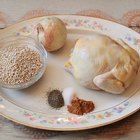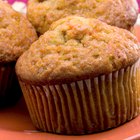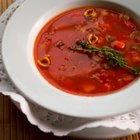
Sauce making is one of the kitchen's most demanding skills, falling somewhere between magic, advanced chemistry and sheer unadulterated culinary prowess. Great chefs of bygone years simplified the process by grouping sauces into families, made with shared ingredients that could be prepared in advance. One of the most useful is a type of concentrated sauce called a demi-glaze.
About Demi-Glaze
Although demi-glaze can be made with beef, chicken, duck and many other ingredients, the classic version uses brown veal stock. The veal bones are roasted and then simmered for hours with a variety of flavoring ingredients, producing a rich stock with a high level of natural gelatin. Then the chef makes a basic brown sauce by thickening a portion of the stock. Finally, the brown stock and brown sauce are mixed half and half, and reduced to one half of their original volume. Modern-day restaurant chefs lighten the classic version and simplify its preparation by skipping the sauce, and just reducing stock to the right consistency.
About Chicken Demi-Glaze
Veal-based demi-glaze, in either the classic or modern version, is added sparingly to sauces to provide them with a base of rich, subtle, meaty flavor. It's neutral enough to be used with poultry, but many chefs prefer to prepare a separate chicken based demi-glaze for use with birds. A brown version is made the same way as veal demi-glaze, by roasting chicken carcasses and chicken bones and then simmering them for stock. If the stock is made with unroasted chicken, it has a paler color and more delicate flavor that's useful in cream sauces and other subtle preparations. In either case, the demi-glaze is made by reducing rich chicken stock by at least half.
Using Demi-Glaze
Chicken demi-glaze provides your foods with a concentrated chicken flavor, without the high levels of salt found in commercial chicken bouillon concentrates. If you add a few spoons of demi-glaze to cream-based or wine-based sauces, it gives them a deep chicken flavor. You can add demi-glaze to the juices from a roasted chicken to make an unusually good gravy, or add it sparingly to steamed rice or risotto to enrich its taste. In a pinch, you can even use it to rescue a weak and watery batch of homemade chicken soup.
Further Reduction
Demi-glaze must be frozen for long-term storage, or you can simply reduce it further. Chicken demi-glaze is usually reduced to half or one-third of its original volume, but if you reduce it further -- to approximately one-sixteenth of its original volume -- it becomes a thick, brown syrupy liquid. In the classical kitchen, that's referred to as "glace de volaille," or poultry glaze. When it cools, it sets to a very firm, rubbery texture because of its high natural gelatin content. Glace keeps for months in the refrigerator, as long as it's sealed to prevent outside contamination. It can be diluted and used like demi-glaze, or melted onto grilled or broiled chicken for an especially bold chicken flavor.
Related Articles

Alternative to Cooking With Chicken ...

How to Reduce Chicken Stock to a Third

Herbs for Chicken Soup
Homemade Cream of Chicken Soup Recipe

Substitute for Light Cream in Cooking

How to Make Fish Stock

How to Cook Moghrabieh

Things You Put in Gumbo

Do You Use Flour or Corn Starch to ...

How to Fry Precooked Chicken

Is Miso Soup Vegan?

How to Make Filipino Chicken Adobo

How to Marinate Roast Chicken

How to Make French Sauce With Roux of ...

Substitute for Manioc Starch
Tasty Crock-Pot Honey Garlic Chicken ...

How to Puree Chicken

How to Make Carnitas

Chicken Stir-Fry With Coconut Milk

Vegetarian Substitutes for Chicken Broth
References
- Larousse Gastronomique, Prosper Montagne (Ed.)
- Professional Cooking; Wayne Gisslen
Writer Bio
Fred Decker is a trained chef and prolific freelance writer. In previous careers, he sold insurance and mutual funds, and was a longtime retailer. He was educated at Memorial University of Newfoundland and the Northern Alberta Institute of Technology. His articles have appeared on numerous home and garden sites including GoneOutdoors, TheNest and eHow.
Photo Credits
Comstock/Comstock/Getty Images